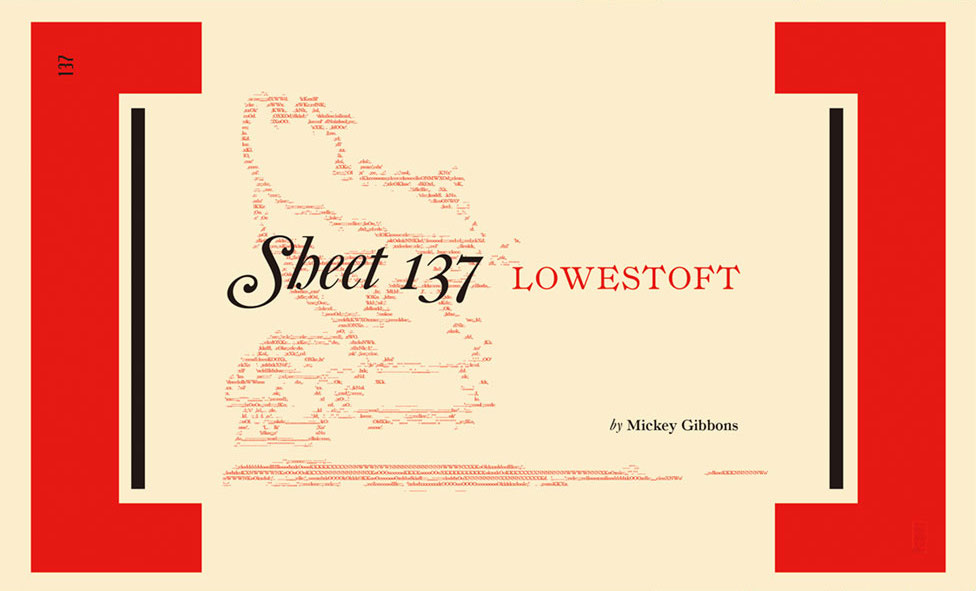Luke Turner flicks through Mickey Gibbons’ ‘Sheet 137’ — a collection of drawings made with a pack of cheap felt tip pens on a journey around the back roads of Suffolk.

The felt tip pen is the recorder of the visual art world: an artistic tool forever associated with the chaos, noise and mess of childhood creativity. Just as the work of long-time Caught by the River contributor Laura Cannell has done with the musical instrument, Mickey Gibbons’ Sheet 137 reclaims the felt tip for landscape art. It’s a lovely coincidence that the county of Suffolk provides so much inspiration for them both.
I first saw, and fell in love with, Gibbons’ felt tip pen drawings of the English landscape on social media, where he’d begun posting them after he left London a few years ago. The self-published Sheet 137 is based on the Ordnance Survey map of the same number, each illustration accompanied with a description and the grid reference. The classic look of the OS also inspires Gibbons’ wonderful design for the book – some readers will know him as one of the founders and designer of the Stool Pigeon music newspaper, and a similarly inventive approach to that which made that dearly departed publication so fantastic has been used here.

This contemporary-yet-traditional homage to the original 1950s map that provides Gibbons with his inspiration really sets off the atmosphere of his drawings. Yet there’s a quietly moving reason for this too – the inspiration came from the map that belonged to Gibbons’ late father, a lifeboat crewman, and it often feels like this collection of drawings is as much a grieving for a man in a landscape as it is a celebration of place.
One of the sunniest areas of the UK, the East Anglian counties are blessed with the kind of light that suits the bright primary colours of the felt tip. Yet the first image, the bright yellow of a field of corn near Oulton, is only one aspect to the diversity of the Suffolk landscape. This is no pure ode to the joys of the arable ideal – a modern Constable rendered in chemical pigment – but more psychedelic and strange. The purple skies of harvest sit in contrast with the fire of stubble and fertile red mud, and simple green and brown of the washed out atmosphere of a field in drizzle. Trees are drawn with great character. Suffolk, like its neighbour Norfolk, is a county with a distinctive magic to its coastline and fields, with dunes, fishing boats, and countless flint churches that date from the prosperity of the Medieval wool trade. Similarly, this is an industrial landscape as much as it is a rural one, and again Gibbons’ felt tip suits the hard lines of pylons, Sizewell B nuclear power station and a distant rugged swing bridge.


Many of the illustrations come accompanied with a little piece of text, guides to Suffolk place and lore, but also excellent little vignettes – a murky sky, drawn from the blue campsite at the Latitude festival, has thoughts about John Bonham: ‘I am confident that Bonham himself spent his entire career trying to make his drums sound as thunderous and threatening as the skies above us’. The joy of those fast-moving skies is the sheer variety of moods and textures that the countryside, in collaboration with the sun (or lack thereof), gives up. You can often see Gibbons’ felt tips moving fast across the page to capture one of these snapshots gifted by the natural world; a simple black line drawing of clouds is full of the promise of rain later.
Most poignant of all is a drawing called Gibbo’s Gap. Abstract in black, it’s a chaos of lines, representing boat, landing, horizon, clouds and then, far out to see, a small red mark, that might be a buoy. The text tells of how the Suffolk shoals must be navigated as if they were a tangle of roads through danger. The text reads, ‘during his twenty years on the lifeboat my father learned a short cut, which took on his moniker. The gap is out there somewhere, but like him, it’s moved on’. Like the rest of this magical book, it’s a simple and poignant elegy to a father, the sea, and the Suffolk landscape in dialogue with it.

*
‘Sheet 137’ is out now and available to buy here, priced £25.